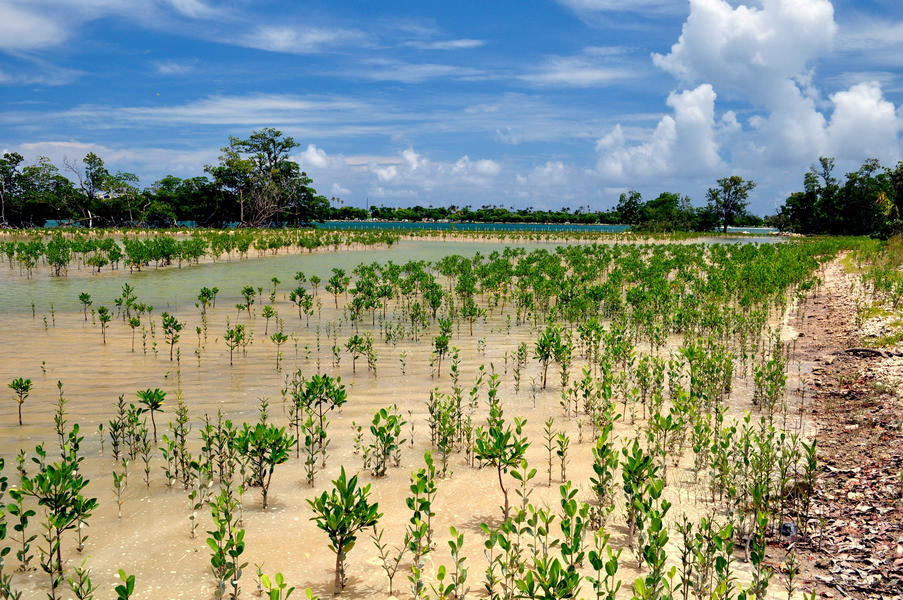Seagrass communities are an integral part of St. Joseph Bay and an important natural resource. They provide nurseries, nutrition and shelter for a wide variety of commercial and recreational fish and invertebrate species, and their extensive root systems stabilize sediments on the bay bottom, helping to improve water quality and clarity, which helps keep the bay healthy. The health and status of many commercially and recreationally important seafood species such as shrimp, crabs, scallops, redfish, trout and mullet are directly proportional to the health and acreage of seagrass habitat.
As human populations concentrate along our coastlines, anthropogenic impacts to seagrass habitats increase through nutrient loading from runoff, light reduction from increased turbidity and phytoplankton blooms, increased boat traffic, and more direct vessel impacts such as propeller scarring (Fonseca, Kenworthy & Thayer, 1998). The goals of the project are to determine seagrass distribution and abundance, trends in seagrass conditions throughout the bay, determine the health of these beds through baseline water quality monitoring efforts, and use ground-truth information to update seagrass coverage maps to compare to historical maps. Future needs for the seagrass monitoring project include the necessity to address specific issues in regard to the seagrass communities of the bay. Prominent and increasing prop scar damage is evident in St. Joseph Bay and with increased visitor use this trend is expected to continue. The extent of this damage must be mapped, documented and monitored and efforts to mark these shallow, sensitive areas should be a high priority effort.
The largest resource management project at St. Joseph Bay Aquatic Preserve is the Florida Seagrass Recovery Project.
As a result of the Deepwater Horizon oil spill and related response activities, submerged aquatic vegetation habitat in the Florida Panhandle was adversely impacted. The Florida Seagrass Recovery project will address boat damage to shallow seagrass beds in the Florida Panhandle by restoring scars located primarily in turtle grass (Thalassia testudinum) habitats in St. Joseph Bay Aquatic Preserve in Gulf County, with additional potential sites in Alligator Harbor Aquatic Preserve in Franklin County and St. Andrews Aquatic Preserve in Bay County.
The project will restore submerged aquatic vegetation habitat by addressing boat scars, which will include surveying and mapping scars in three aquatic preserves in the Florida Panhandle. Additionally, sediment tubes will be manufactured, filled with local fine grain sediment, and deployed in approximately two acres of seagrass propeller scars in St. Joseph Bay Aquatic Preserve. However, if approximately two acres of propeller scars are not found to be available for this restoration project in St. Joseph Bay Aquatic Preserve after initial assessments, then additional potential sites will be selected in one of the other aquatic preserves to achieve the overall project goal of restoring approximately two acres of scars.
The sediment tubes, which are made of biodegradable cotton fabric filled with sediment, will then be placed into propeller scars to enhance seagrass recovery by raising the scar elevation to ambient grade with clean sediment of appropriate grain size, thereby offering suitable habitat for seagrass recruitment. Restoration will be facilitated by placing bird stakes in the project area. The stakes attract birds to perch and supply natural fertilizer in the form of feces, which is rich in phosphorus and nitrogen. Bird stakes will be installed in water depths of 5 feet or less at mean high tide. Following completion of installation, any bird stakes remaining after two years will be removed.
Two growing seasons (approximately 18 to 24 months) after placement of sediment tubes and bird stakes is completed, scars that do not naturally revegetate to 25 to 50 percent coverage will either be planted with seagrass species transplanted from potential donor sites within the aquatic preserve, or planted with purchased seagrass planting units, as funding allows.
Finally, a boater outreach and education component of the project will install non-regulatory Shallow Seagrass Area signage at sites where restoration takes place, update existing signage and buoys where applicable, install educational signage, and provide brochures about best practices for protecting seagrass habitats at popular boat ramps in St. Joseph Bay, Alligator Harbor and St. Andrews Bay.


